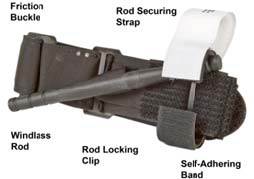Combat Application Tourniquet: Difference between revisions
From Protocopedia
| Line 7: | Line 7: | ||
The C.A.T. uses a self-adhering band and friction adaptor buckle to fit a wide range of extremity sizes combined with a one-handed windlass system. The windlass system uses a free moving internal band to provide even circumferential pressure to the extremity. | The C.A.T. uses a self-adhering band and friction adaptor buckle to fit a wide range of extremity sizes combined with a one-handed windlass system. The windlass system uses a free moving internal band to provide even circumferential pressure to the extremity. | ||
[[File:Picture_of_CAT.jpg|left|Combat Application Tourniquet]] | |||
====EQUIPMENT:==== | ====EQUIPMENT:==== | ||
Revision as of 14:31, 11 April 2014
Procedure Guidelines
9.36 COMBAT APPLICATION TOURNIQUET
Severe traumatic extremity injuries with uncontrolled bleeding may sometimes require the application of a tourniquet. The Combat Application Tourniquet (C.A.T.) is designed to provide effective pressure on the injured extremity to occlude arterial bleeding. The C.A.T. is approved for use by SCEMS personnel where tourniquet application is indicated. See PP 6.06 “Extremity Injuries” for indications.
FEATURES:
The C.A.T. uses a self-adhering band and friction adaptor buckle to fit a wide range of extremity sizes combined with a one-handed windlass system. The windlass system uses a free moving internal band to provide even circumferential pressure to the extremity.

